

Aztec Mythology - Myth Encyclopedia - god, story, legend, names, ancient, animal, snake, war, world, creation. The mythology of the Aztec civilization, which dominated central Mexico in the 1400s and early 1500s, described a universe of grandeur and dread.
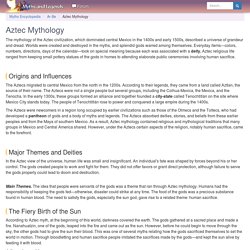
Worlds were created and destroyed in the myths, and splendid gods warred among themselves. Everyday items—colors, numbers, directions, days of the calendar—took on special meaning because each was associated with a deity. Aztec religious life ranged from keeping small pottery statues of the gods in homes to attending elaborate public ceremonies involving human sacrifice. Aztec religion. Religion of the Aztecs The Aztec religion originated from the indigenous Aztecs of central Mexico.
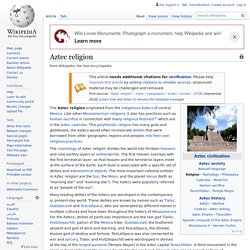
Like other Mesoamerican religions, it also has practices such as human sacrifice in connection with many religious festivals[1] which are in the Aztec calendar. This polytheistic religion has many gods and goddesses; the Aztecs would often incorporate deities that were borrowed from other geographic regions and peoples into their own religious practices. The cosmology of Aztec religion divides the world into thirteen heavens and nine earthly layers or netherworlds. Aztec Empire for Kids: Government and Empire. History >> Aztec, Maya, and Inca for Kids Empire The Aztec Empire was made up of city-states.

At the center of each city-state was a large city that ruled the area. Uto-Aztecan language. Nahuatl language, Spanish náhuatl, Nahuatl also spelled Nawatl, also called Aztec, American Indian language of the Uto-Aztecan family, spoken in central and western Mexico.

Nahuatl, the most important of the Uto-Aztecan languages, was the language of the Aztec and Toltec civilizations of Mexico. A large body of literature in Nahuatl, produced by the Aztecs, survives from the 16th century, recorded in an orthography that was introduced by Spanish priests and based on that of Spanish. The phonology of Classical Nahuatl, the language of the Aztecs, was notable for its use of a tl sound produced as a single consonant and for the use of the glottal stop. The glottal stop has been lost in some modern dialects—replaced by h—and retained in others.
eCUIP : The Digital Library : Science : Cultural Astronomy. Cultural Background The Aztecs ruled an empire in middle and southern Mexico that was at its strongest during the 15th and 16th centuries (1400's and 1500's) AD.
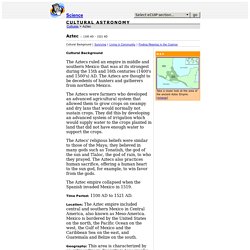
The Aztecs are thought to be decedents of hunters and gatherers from northern Mexico. The Aztecs were farmers who developed an advanced agricultural system that allowed them to grow crops on swampy and dry lans that would normally not sustain crops. They did this by developing an advanced system of irrigation which would supply water to the crops planted in land that did not have enough water to support the crops.
Effect of Geography on the Maya, Aztec & Inca Civilizations - Video & Lesson Transcript. Japanese Gods – Mythopedia. Japan Demographics 2020 (Population, Age, Sex, Trends) - Worldometer. Population of Japan (2020) View live population, charts & trends: Population of Japan Japan Population Fertility in Japan A Total Fertility Rate (TFR) of 2.1 represents the Replacement-Level Fertility: the average number of children per woman needed for each generation to exactly replace itself without needing international immigration.
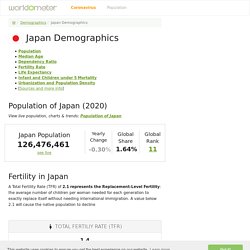
A value below 2.1 will cause the native population to decline pregnant_woman Total Fertiliy Rate (TFR) (Live Births per Woman, 2020) Life Expectancy in Japan See also: Countries in the world ranked by Life Expectancy Both Sexes 85.0 years (life expectancy at birth, both sexes combined) Females 88.1 years (life expectancy at birth, females) Males 81.9 years (life expectancy at birth, males) Infant Mortality Rate and Deaths of Children under 5 Years Old in Japan Infant Mortality (infant deaths per 1,000 live births) The Government of Japan - JapanGov.
Religion in Japan. Shinto and Buddhism are Japan's two major religions.

Shinto is as old as the Japanese culture, while Buddhism was imported from the mainland in the 6th century. Since then, the two religions have been co-existing relatively harmoniously and have even complemented each other to a certain degree. Most Japanese consider themselves Buddhist, Shintoist or both. Religion does not play a big role in the everyday life of most Japanese people today. The average person typically follows the religious rituals at ceremonies like birth, weddings and funerals, may visit a shrine or temple on New Year and participates at local festivals (matsuri), most of which have a religious background. Religions and Philosophies Other Religion Related Pages. What is the weather, climate and geography like in Japan. Weather and climate Best time to visit The climate in Japan is mostly temperate with four distinct seasons, except for the Hokkaido area and the Okinawa region.

Tokyo, along with most areas on the main island Honshu, has a humid subtropical climate characterised by warm and wet summers and mild winters. January is usually the coldest month while August is the hottest month. September and October are the main rainy season, and umbrellas are a daily essential during this period. Spring and autumn are generally mild throughout the country. Typhoons or tropical cyclones with strong winds and torrential rains often hit Japan during August and September but can occur through May to October. The best time to visit Tokyo is usually from March to May and late September to November.
Languages of Japan. The most widely spoken language in Japan is Japanese, which is separated into several dialects with Tokyo dialect considered standard Japanese.

In addition to the Japanese language, Ryukyuan languages are spoken in Okinawa and parts of Kagoshima in the Ryukyu Islands. Along with Japanese, these languages are part of the Japonic language family,[2] but they are separate languages, and are not mutually intelligible with Japanese, or with each other. All of the spoken Ryukyuan languages are classified by UNESCO as endangered. Polynesian Mythology - Myth Encyclopedia - god, legend, war, world, creation, life, hero, people, children. Polynesia is a vast region of the Pacific Ocean consisting of many hundreds of widely separated, culturally and politically diverse island groups.
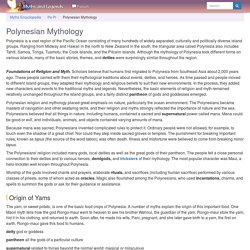
Ranging from Midway and Hawaii in the north to New Zealand in the south, the triangular area called Polynesia also includes Tahiti, Samoa, Tonga, Tuamotu, the Cook Islands, and the Pitcairn Islands. Although the mythology of Polynesia took different forms on various islands, many of the basic stories, themes, and deities were surprisingly similar throughout the region. Foundations of Religion and Myth. Scholars believe that humans first migrated to Polynesia from Southeast Asia about 2,000 years ago. Hawaiian Myths and Legends. Hawaii is full of myths and legends - stories that are full of passion, betrayal, loyalty, birth and death.
According to W.D. Polynesia - New World Encyclopedia. Polynesia is generally defined as the islands within the triangle Polynesia (from the Greek words meaning "many islands") is a large grouping of over one thousand islands scattered over the central and southern Pacific Ocean. Polynesian culture - Religion. Polynesian belief systems emphasized animism, a perspective in which all things, animate and inanimate, were believed to be endowed to a greater or lesser degree with sacred supernatural power. That power, known among Polynesians as mana, could be nullified by various human actions, and many of the region’s tapu (“prohibitions” or “taboos”) were intended to prevent such behaviours. As is typical of animist cultures, religious concerns permeated all aspects of life. Polynesian chiefs had great mana—so great, in fact, that in some societies, if a commoner touched the chief’s shadow, only that person’s death could compensate for the injury to the chief’s mana.
In much of Polynesia it is still considered to be in very poor taste to step over a person’s legs, pass one’s hand over a person’s head, or stand with one’s head higher than that of a person of high rank, because these actions are believed to sap a person’s mana. Robert Carl Suggs Robert C. Polynesian languages. History, Religion, Traditions, & Facts.